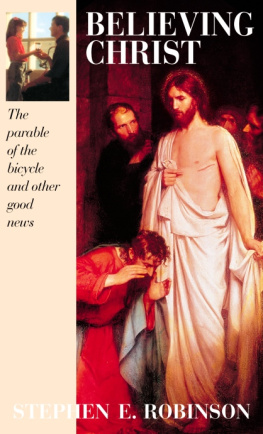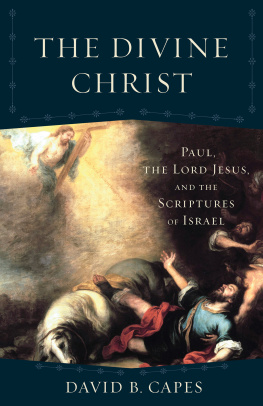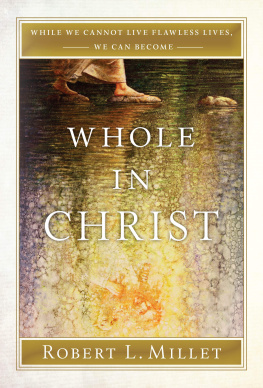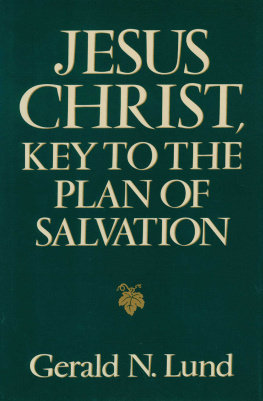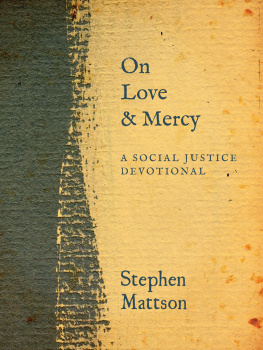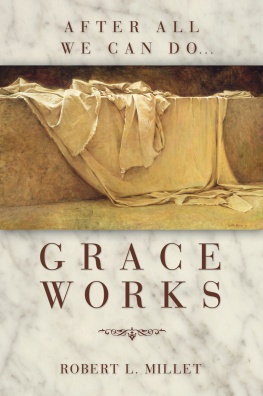Believing Christ
The Parable of the Bicycle and Other Good News
Stephen E. Robinson
1992 Stephen E. Robinson.
All rights reserved. No part of this book may be reproduced in any form or by any means without permission in writing from the publisher, Deseret Book Company, P.O. Box 30178, Salt Lake City Utah 30178. This work is not an official publication of The Church of Jesus Christ of Latter-day Saints. The views expressed herein are the responsibility of the author and do not necessarily represent the position of the Church or of Deseret Book. Deseret Book is a registered trademark of Deseret Book Company.
For Sarah, Rebekah,
Emily, Michael,
Mary, and Leah.
Thanks.
PREFACE
Since coming to Brigham Young University a few years ago, I have noticed a peculiar and unexpected thing. New freshmen arrive at BYU from wards and branches all over the Church. The majority have been in the Church for a relatively long time, even, I suspect, most of their lives, and they are generally well trained in the peripherals of the gospel. They know a surprising amount about tithing, the Word of Wisdom, genealogy, LDS dating, food storage, and so forth. Of course all of these are important principles for the Latter-day Saints and make up part of the fullness of the gospel in the latter days. But these are not the central doctrines of the gospel as taught in all dispensations from the beginning of the world to its end.
What I noticed about my students was that, as we moved in class from peripheral doctrines and practices of the Church to the central doctrines of the gospel, many of them became less and less sure of themselvesthey were soft in the middle. Some were even more comfortable defining themselves in terms of what they didn't believe (predestination, original sin, and so forth) than in terms of what they did believe. A significant minority did not understand scriptural doctrines such as salvation by grace, justification through faith in Christ, sanctification, atonement, and the meaning and terms of the gospel covenant. They were well taught in the peripherals but not in the vitals of the restored gospel.
I am sure most of this is a function of age and maturity rather than of intelligence and training. Nevertheless, as a result of this discovery, I decided to write several lectures specifically to fill this gap for my students. These lectures were intended to set out the central doctrines, the real "good news" of the gospel, in clear and simple terms drawn both from the scriptures and from practical experience. Since these lectures have met with some success, this book is the logical result.
I thank those who shared with me in the experiences I relate, particularly my wife, Janet, for allowing them to be retold here where they can possibly bless others who may find themselves in similar circumstances. In cases not involving my own family, I have altered some of the names and other descriptive databut not the experiencespertaining to individuals. In one case, characteristics of several persons with similar stories have been combined into one character.
I need to say a word here about my wife, Janet, since one of the key experiences related hereafter is mostly hers and is intensely personal, and since someone once suggested that relating it put her in a bad light and made her husband look good at her expense. Janet and I normally think in terms of us rather than in terms of her or me, but if we must compare individual statures, I think the following sketch represents the approximately correct proportions.
When Janet approaches the pearly gates, the Lord may say to the angels something like this, "Why, look everybodyhere comes Janet Robinson! Janet's finally here! Let's all go out to welcome her and bring her in." But as he greets her on the steps, he will probably stop and add, "Janet, what on earth is that sorry thing you're dragging behind you?" To which she will respond, "Oh, that? That's my husband. Can I bring him in too?" Without her I haven't got a chance, and this can be confirmed by anyone who knows us well.
I have long maintained that a book without notes is usually not worth reading, since a lack of documentation indicates that the contents are the author's own opinions unsupported by outside scholarship. In this case, I plead guilty. Documenting oneself or one's own experiences, reflections, and views is very hard. Thus readers will either agree with my opinions or disagree, as they choose. Because the material here is personal, I have tried to use the same style I would in the classroom or in conversation, including the colloquial and elliptical, the ironic and the sarcastic. For this I apologize to Miss Wood, my seventh-grade English teacher, who taught me to know better. I claim no outside authority as proof of any of these private opinions, though I have dutifully inserted as many notes as I could manage in a book of this nature, which though ostensibly theological is also unabashedly devotional. And I would like the reader to know that I believe what is said here.
I must also make it clear that I have written this book as a believing Latter-day Saint writing to an audience of other Latter-day Saints. I make no claim of detached scholarly objectivity. If this were a paper for my professional colleagues in the academic field of religion, the methodology and tone would be considerably different. But there is nothing wrong with being bilingual, and in this book I choose to speak the language of faith.
I am frequently asked how a department chair finds the time to write a book. In this case the answer is outstanding secretarial support. Thanks go to Joell Woodbrey for protecting me from nonessentials.
A small part of this book was delivered in May 1990 as a BYU Devotional Address titled "Believing Christ: A Practical Approach to the Atonement," and it appeared both in the November 1990 issue of BYU Today and in Brigham Young University 1989-90 Devotional and Fireside Speeches (Provo: University Publications, 1990). A slightly revised version of that address was also reprinted in both the Ensign and the International Magazines of the Church in April 1992.
Neither this book nor its author has any authority to speak for The Church of Jesus Christ of Latter-day Saints. The ideas expressed here represent a sincerely held but strictly personal point of view.
Chapter One
THE GREAT DILEMMA
For human beings the greatest problem in all the universe, the greatest contradiction, dilemma, or dichotomy there is consists of two simple facts. The first of these two facts is clearly stated in Doctrine and Covenants 1:31: "For I the Lord cannot look upon sin with the least degree of allowance."
This seems a harsh scripture, for it clearly states that God cannot tolerate sin or sinfulness in any degree. He can't wink at it, or ignore it, or turn and look the other way. He won't sweep it under the rug or say, "Well, it's just a little sin. It'll be all right." God's standard, the celestial standard, is absolute, and it allows no exceptions. There is no wiggle room.
Many people seem to have the idea that the Judgment will somehow involve weighing or balancing, with their good deeds on one side of the scales and their bad deeds on the other. If their good deeds outweigh their bad, or if their hearts are basically good and outweigh their sins, then they can be admitted into the presence of God. This notion is false.
As Doctrine and Covenants 1:31 and other scriptures illustrate, God cannot, will not, allow moral or ethical imperfection in any degree whatsoever to dwell in his presence. He cannot tolerate sin "with the

